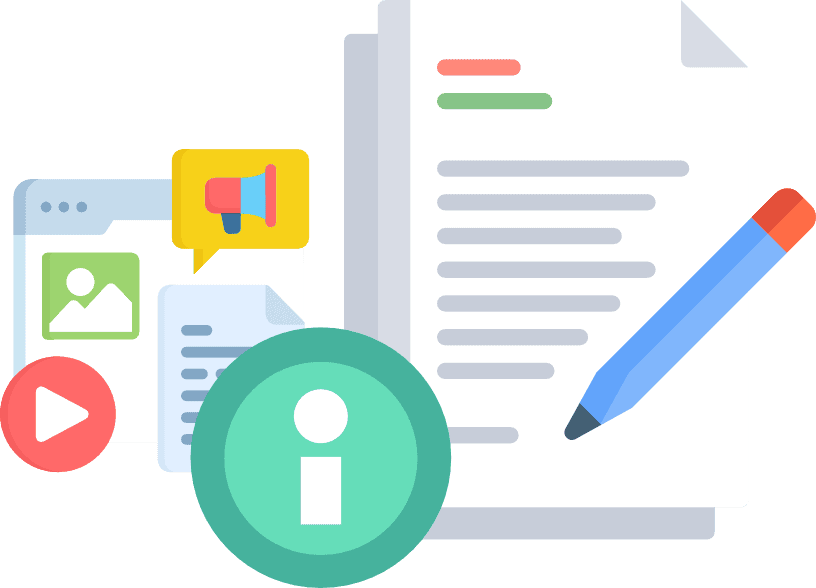A lot of content is created and shared on the internet every day. From memes to humoristic videos, music clips, and poems, to commentary and news reports, it can feel like sharing other people’s work has become the norm and that nothing is off-limits.
However, that is not the case.
Copyright laws exist and not everything is permissible. If you are using someone else’s work, read on to learn more about how you can protect yourself by using a Fair Use disclaimer.
- Including a Fair Use disclaimer can lower the risk of copyright infringement lawsuits by showing you’re aware the material is not your intellectual property.
- While a Fair Use disclaimer is not legally required, it’s a smart practice to demonstrate your understanding of copyright law and good intentions.
- The effectiveness of a Fair Use disclaimer depends on the nature of your use and doesn’t guarantee immunity from copyright infringement lawsuits.
Table of Contents
PRO TIP: Take the hassle of writing your own disclaimer away with our disclaimer generator trusted by over 200,000 businesses. It’ll save you hours of work and possible costly legal mistakes.
What Is a Fair Use Disclaimer?
A Fair Use disclaimer is a short statement that serves to inform the public that you recognize that some of the copyrighted content used on your website or video is not yours.
Even so, you also consider that your use of said copyrighted work is legal, as it falls under the doctrine of Fair Use.
The Fair Use Doctrine
Fair Use is a concept rooted in the United States Copyright laws, more specifically Title 17, Section 107 of the United States Code. It strives to strike a balance between protecting individual intellectual property and promoting freedom of expression.
Similar doctrines have been adopted and adapted by many jurisdictions worldwide. Fair Use is an ever-evolving concept as technology makes the sharing of information easier and our world more global than ever.
In Section 107 of the Copyright Act of 1976, legislators have provided for some very specific circumstances under which one may use someone else’s copyrighted material without requiring permission from the rights holders first nor raising any copyright infringement concerns.
Under that section of the law, allowance is made for purposes such as criticism, commentary, news reporting, teaching, education, and research.
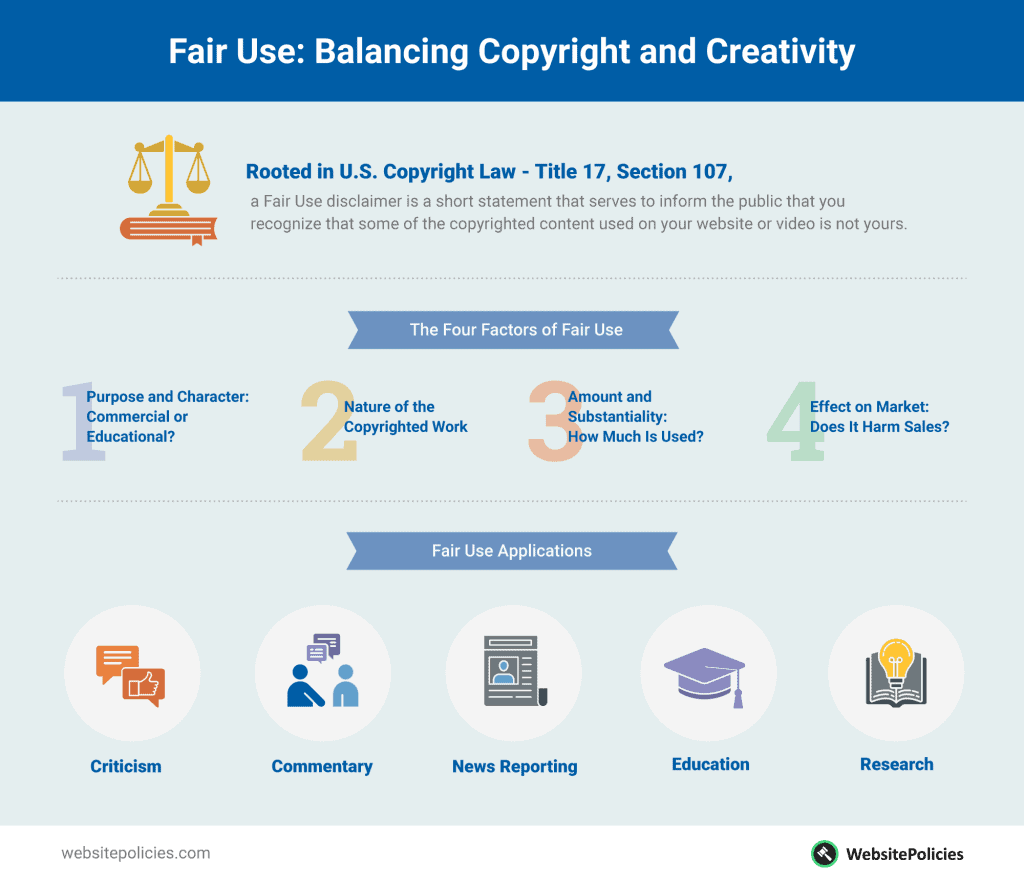
Why Do You Need a Fair Use Disclaimer?
If you own a website, a podcast, or a YouTube channel and are quoting someone’s work, using their music or one of their videos, or any work that they own without having first requested their express consent, you should include a Fair Use statement.
That is, of course, if you believe that what you are doing falls under the Fair Use doctrine as seen above.
By being forward and informing your readers that the materials used are not your intellectual property and that you did not seek permission to use it from the rightful copyright holder beforehand because you deem your usage to be Fair Use, you may well be lowering your chances of being faced with a copyright infringement lawsuit.
After all, you are assuming responsibility and acknowledging that portion of a work is not your own. Why?
Recognizing that the work is not yours could facilitate communication with the copyright owner should they be unhappy with your use of their work. It can act as a deterrent and open up communication channels other than the courts.
However, adding a copyright Fair Use notice on your website is not a magic solution and will not protect you from being served with a copyright infringement lawsuit. It will not free you from having to pay damages if your use doesn’t fall under the Fair Use doctrine and thus violates someone’s copyright.
You should always be careful when using work that is not your own as it poses a risk, particularly if what you do with their work could offend them or affect them financially.
Even if, legally, your activity would potentially fall under Fair Use if your case was put in front of a judge, you may wish to exercise discretion to avoid a lawsuit and its associated costs.
Is a Fair Use Disclaimer Legally Required?
No, a Fair Use disclaimer is not legally required. However, using one is recommended and can be a smart move to protect yourself from potential copyright infringement claims.
To put it into perspective, think of it as putting a “Wet Floor” sign down when you mop your kitchen floors. You’re not legally obligated to do it, but it helps avoid accidents and shows you’re being responsible.
So, while it isn’t a magic shield, it can demonstrate your good intentions and understanding of copyright law. It can also help educate viewers about Fair Use and avoid confusion.
When Do You Need a Fair Use Disclaimer on Your Website?
With so much information readily available online, it’s normal that a website may contain copyrighted material, whether it be text, images, music, or videos.
While copyright law protects original creative works, there exists a crucial exception known as Fair Use. This law allows limited use of copyrighted material without permission for particular use cases.
That said, the effectiveness of one depends on the specific circumstances of your website and the nature of your content. Here are examples of activities where a website must draft a Fair Use disclaimer:
Educational Websites
If your website includes content for educational purposes, a Fair Use disclaimer can underscore your commitment to the Fair Use principles. It helps reinforce that the use of copyrighted material is intended for educational and not-for-profit reasons.
Commentary or Criticism
When your website provides commentary or critiques on copyrighted material, a Fair Use disclaimer can signal your awareness of the Fair Use doctrine. This is particularly relevant if your content involves reviews, analyses, or discussions of copyrighted works.
News Reporting
If your website disseminates news or reports current events, including a Fair Use disclaimer can help clarify that your use of copyrighted material is within the bounds of Fair Use for reporting purposes.
Parody and Satire
If your site produces content for comedic or satirical purposes, a Fair Use disclaimer can highlight that your use of copyrighted material is for creative expression and not for commercial gain.
Can You Copy and Paste Fair Use Disclaimer From Another Website?
No, you can’t copy and paste a fair use disclaimer from another website. Copying content directly from another website, including disclaimers, can infringe on the copyright of the original creator.
It’s important to create your own disclaimer to reflect on how your website operates. You can use a template as a starter and tailor it to your specific needs.
If you’re looking for a specific style or format used by other websites, it’s best to use them as a reference and create a unique version for your own. Always ensure that any legal text on your website is compliant with your local laws and regulations.
The Fair Use Act Under the Law
Determining if an activity or use falls under the doctrine of Fair Use should not be taken lightly. If you are not convinced that how you are using the copyrighted material is legal, you should contact and ask permission from the copyright owner and, at a minimum, add a Fair Use disclaimer.
To be able to determine if a certain activity is likely to be considered Fair Use of the copyrighted material, here is a four-factor balancing test you can refer to:
1. The purpose and character of the use, including whether such use is commercial or is for nonprofit educational purposes
Generally speaking, it would likely be easier to prove that copyright is not infringed if the content of your website is for educational purposes or promotes innovation and creativity by introducing a new concept or adding on to the copyrighted work.
It constitutes Fair Use if the work is considered transformative and thus helps in making an effective Fair Use argument.
2. The nature of the copyrighted work
Copyright law puts great importance on protecting original art and creative works so it might be harder to argue Fair Use. In comparison, sharing facts or science, such as research papers, is beneficial to the public.
Along the same lines, except in some rare circumstances, using unpublished work would hardly be considered Fair Use as it would have a significant impact on the copyright owner.
3. The amount and substantiality of the portion used to the copyrighted work as a whole
Among the four factors, this is a very circumstantial factor as both quantity and quality have to be evaluated to determine if the use is fair or not in the context.
4. The effect of the use upon the potential market for or value of the copyrighted work.
If your use of copyrighted materials affects the earning potential of the copyright owner, if you were selling prints of original paintings without having the artist’s permission, for example, you would be hard-pressed to find a court that will side with you.
When asked to weigh in on a copyright infringement complaint, courts will look at the above-mentioned factors.
They will also consider the extensive case law that was developed over the years to account for situations and circumstances that were not specifically considered when the law was enacted, like recent technological developments, for example.
Where to Display Your Fair Use Disclaimer
Where to display your Fair Use notice will depend on what type of media the copyrighted content appears on. But one thing is certain, it should be prominent.
Website
Website owners who regularly share snippets of copyrighted material should strongly consider including a general Fair Use notice.
This notice, located in the legal section of the website, informs visitors of your intention to use copyrighted material under the fair use doctrine. Additionally, adding a hyperlink to the notice in the website footer enhances accessibility for your audience.
With these simple steps, you can demonstrate your commitment to responsible content sharing and create a more informed online environment.
YouTube Video
In a YouTube video, users often include a disclaimer for Fair Use in the description or the first few seconds of the video. This is good practice if you believe that you are not infringing on anyone’s copyright. Take the time to learn how to write a Fair Use disclaimer as justification.
Note that, similar to how having a Fair Use notice on your website will not guarantee that you will not receive a copyright infringement complaint, having one in your video description will not prevent anyone from submitting a DMCA takedown notice to a service provider, such as YouTube.
That said, it could serve as a reminder to copyright holders that they should consider the Fair Use doctrine before sending a takedown notice.
Here’s an example of a Fair Use and copyright disclaimer in a video description:

This is from a YouTube video titled “How Wolves Change Rivers” by Sustainable Human. This notice transparently acknowledges the presence of copyrighted material and asserts its use solely for educational purposes. It serves as a preemptive legal defense, demonstrating good-faith efforts to adhere to fair use principles.
Fair Use Disclaimer Examples
Using copyrighted work without permission can be tricky. Here are a few practical examples of Fair Use disclaimers to guide you:
Hit Songs Deconstructed
Hit Songs Deconstructed is a platform that offers songwriting analysis and trend reports. Its mission is to help music industry professionals by supporting their creative process through data.
As such, the platform consists of a database filled with hit songs and information about them. By browsing through it, you can select a song and listen to audio clips as well as watch the official music videos.
Here is how Hit Songs Deconstructed displays its fair use notice in its website footer:
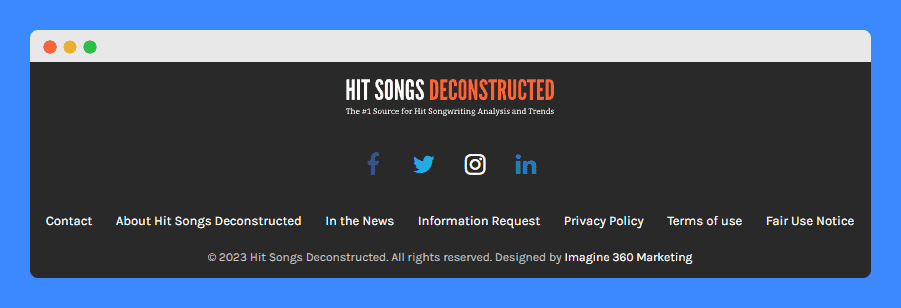
Clicking on the words “Fair Use Notice” brings you to a page where one can read through the full disclaimer:
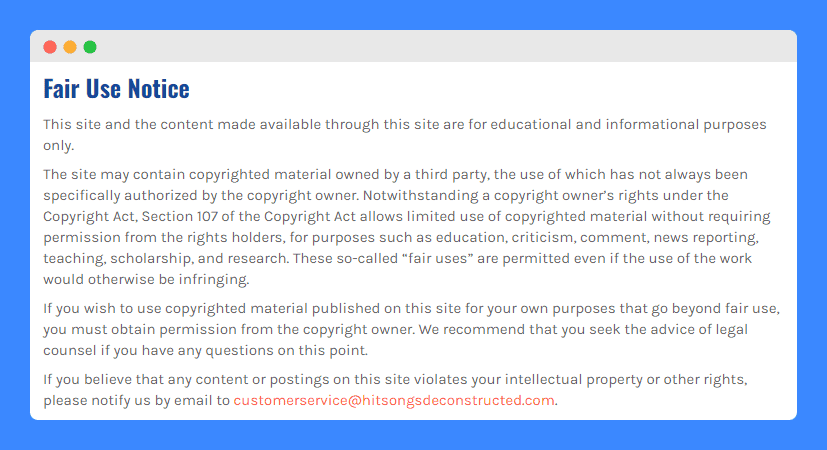
As you can see from the above, Hit Songs Deconstructed justifies its use of copyrighted materials by emphasizing the fact that the content is made available through its platform for educational and informational purposes only.
Oregon Center for Public Policy
The Oregon Center for Public Policy is a non-profit organization that aims to make political, economic, and tax issues understandable to its citizens.
It also adequately advocates for them in front of stakeholders, which it does through its research, analysis, communication efforts, and collaboration with lawmakers.
The following disclaimer appears on its website about a specific article:
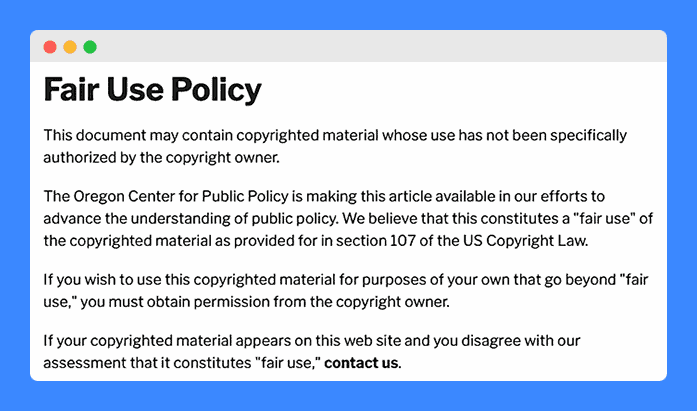
Again, this is a fairly standard disclaimer notice in which the Center specifies that the article is made available to advance the understanding of public policy, which it deems falls under the doctrine of fair use.
Starr Commonwealth
Starr Commonwealth is a global organization that caters to both children and adolescents who are victims of trauma by offering community-based programs and educational and behavioral health services.
It also helps professionals by providing them with training resources and certifications, both in-person and online.
The organization links to its Fair Use notice in its website footer:
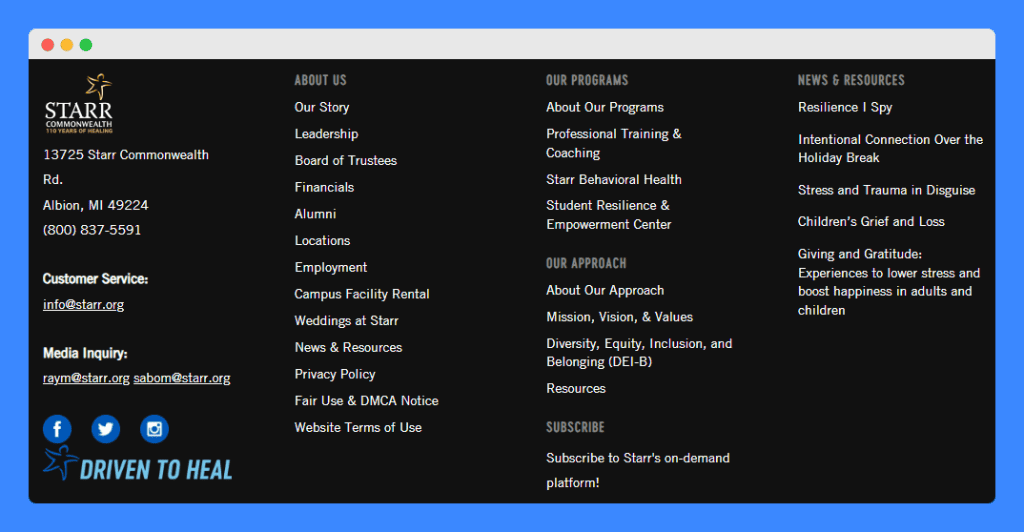
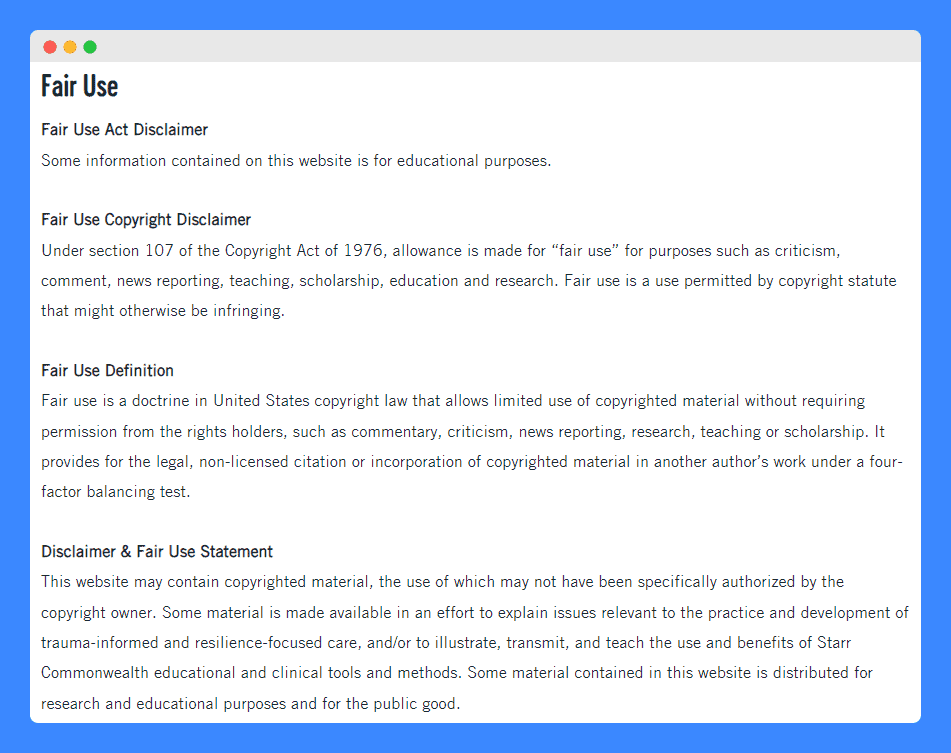
This is a bit more detailed than the previous disclaimers and vulgarizes the concept of fair use by providing a definition and highlighting the fact that it is an important concept, especially for online non-profit and educational projects such as theirs.
You will also note that, on this same page, the organization includes its DMCA takedown notice process and includes the contact information of its copyright agent.
Sample Fair Use Disclaimer Template
This sample template will help you learn how to write a Fair Use disclaimer but remember that it’s just an example. It’s a good idea to include other important topics within your Fair Use copyright disclaimer for proper legal coverage.
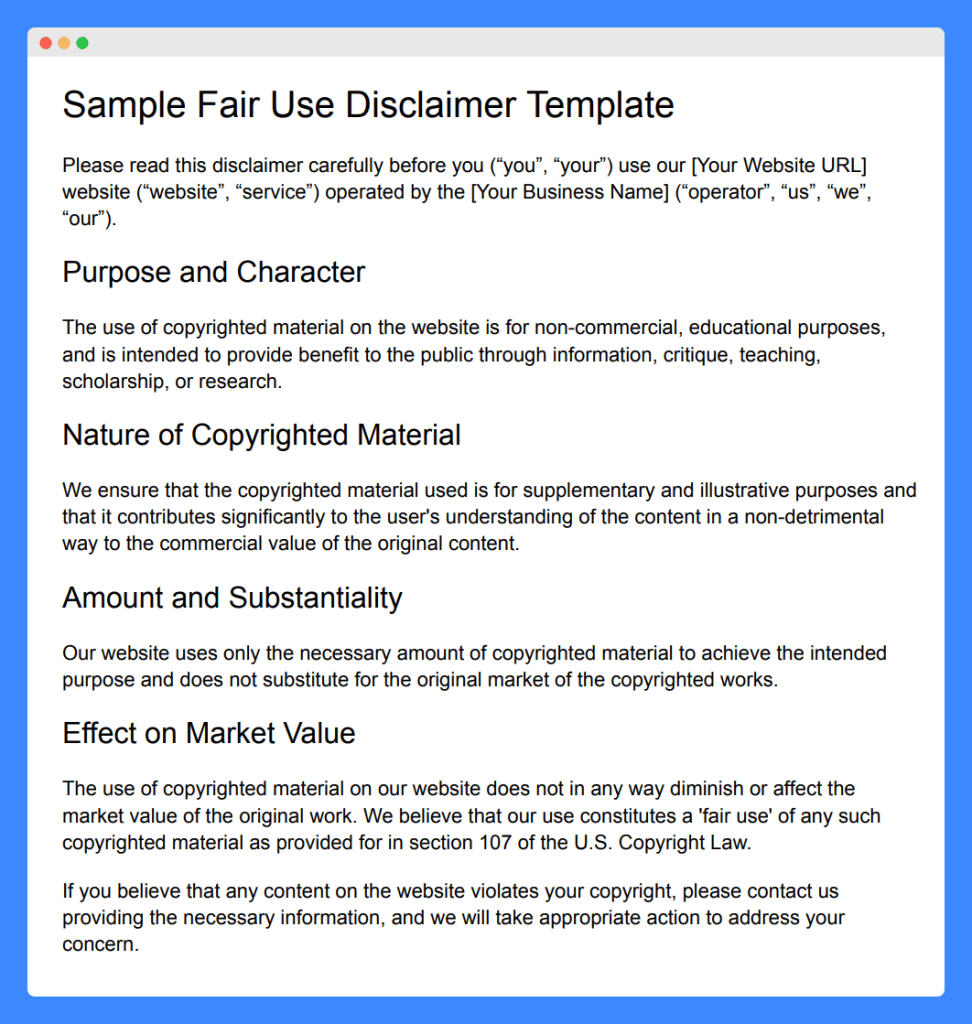
Frequently Asked Questions
What is copyright fair use notice?
A copyright fair use notice is a statement indicating that you’re using copyrighted material under fair use for purposes like criticism, education, or research, without needing permission from the copyright owner.
Does a Fair Use disclaimer guarantee protection from copyright claims?
No, a Fair Use disclaimer doesn’t guarantee protection from copyright claims. It serves as a communication tool but doesn’t offer legal immunity.
What is a fair use disclaimer for YouTube?
A fair use disclaimer for YouTube typically states that your video may contain copyrighted material used under the Fair Use doctrine for purposes such as criticism, comment, news reporting, teaching, scholarship, or research.
Can you claim Fair Use for commercial purposes?
Yes, you can claim fair use for commercial purposes, but your use must still meet the criteria of fair use, which can be more challenging for commercial endeavors.
What do you do if you receive a copyright infringement claim despite having a Fair Use disclaimer?
If you receive a copyright infringement claim despite having a Fair Use disclaimer, you should consult a legal professional to review your content and the claim, and then respond appropriately to the claimant or platform hosting your content.

